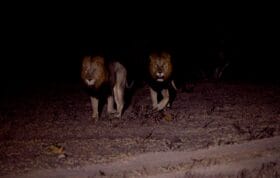We don’t often encounter the Nyelethi young female anymore. After the death of her mother (not witnessed, but believed to be in early 2011), she shifted her territory northwards, away from the Manyelethi Riverbed.
As the only female in a litter of three, the pressure placed upon her at kills by her two brothers forced her into independence at an early age, and she would make regular excursions outside Londolozi’s borders.
Powerful descendant of Saseka Female, a skilled huntress defied odds by raising intact litter of three cubs to independence in Londolozi.
This footage below is from 2009 and shows the Nyelethi female and her two brothers feeding with their mother.
It seems now that she has really grown up as we have recently seen her mating for what as far as we know is the first time. Her suitor was the Gowrie male, a large leopard usually found over our Northern boundary.
Time will tell whether or not this mating results in pregnancy and cubs, but for now it is enough to know that she is ready to have a litter of her own.

The Nyelethi young female in early 2012 near the Manyelethi River. She is not often encountered along the Manyelethi’s southern reaches anymore.

The Gowrie male rears over the Nyelethi young female during a bout of mating. f3.2, 1/400s, ISO 800.

Mating bouts were fairly frequent between the two leopards. This can indicate that they have not been mating for much longer than a day or two. f4.5, 1/320s, ISO 2500
The Gowrie male first appeared in the Sabi Sands around 2011. Judging by his size, he is estimated to have been born around 2005/6.
As an apparently fully mature female, this hopefully means that we will be seeing a lot more of her in an established area.
Written and filmed by James Tyrrell and Richard Laburn
Photographed by James Tyrrell and David Dampier


















Hi James and Rich, is the one you are calling the Gowrie Male Mvula, or Tingana ? I know the Gowrie Male used to be Mufufunyane, but can’t remember who you are calling it now.
Gowrie Male is known as Lamula to the north of us. Mvula and Tingana are different leopards also seen in the north. Hope this helps!
Kate
Thanks for the answer Kate, I just wondered as both Mvula and Tingana are seen more at Gowrie than Lamula is.
Mother Nature at her finest–how beautiful!